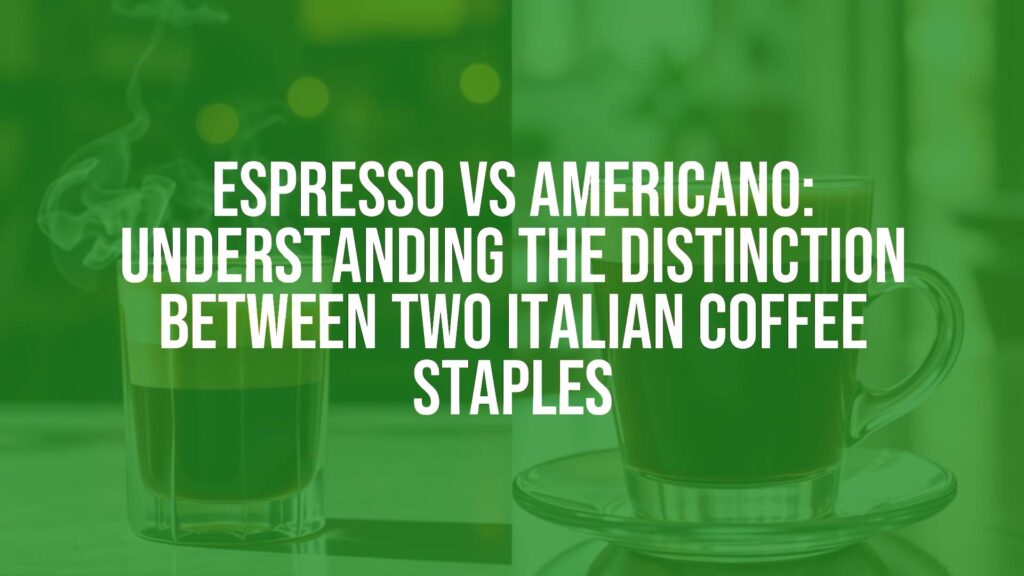Espresso vs Americano: Exploring the Key Differences and Similarities
Introduction
Italian coffee culture has introduced the world to a variety of iconic beverages, among which espresso and Americano have become mainstays in cafés worldwide. Though closely related, these coffee drinks offer distinct experiences in flavor, preparation, and presentation. This article aims to clarify the core contrasts and commonalities between espresso and Americano, helping coffee enthusiasts appreciate what sets each one apart.
Historical Context: The Origins of Espresso and Americano
Espresso originated in Italy in the early 20th century, born from a desire to create a quick, intense coffee extraction. Its rise coincided with the development of the espresso machine, giving birth to Italy’s unique coffee bar culture. The Americano, on the other hand, is believed to have emerged during World War II when American soldiers in Italy diluted espresso with hot water, seeking a brew similar to the drip coffee popular back home.
Core Ingredients and Their Roles
Both drinks start with the same foundation: finely ground, high-quality coffee beans. The essential distinction lies in what follows the extraction process. Espresso consists solely of coffee and is served in a concentrated shot, while Americano combines that same espresso base with added hot water, significantly altering its profile and volume.
Preparation Methods
Espresso is made by forcing hot water at high pressure through a tightly packed puck of finely ground coffee, resulting in a small, potent shot topped with a layer of crema. The Americano, meanwhile, starts with one or more shots of espresso, which are then diluted with a specific amount of hot water—typically in a 1:1 to 1:3 ratio, though preferences vary. This produces a drink closer in strength and body to filter coffee, but with an espresso’s flavor base.
Flavor, Texture, and Appearance
Espresso is celebrated for its robust, concentrated flavor, velvety mouthfeel, and trademark crema, a creamy golden foam that floats atop the shot. Its intense taste features pronounced notes of chocolate, caramel, fruit, or nut, depending on the blend. In contrast, the Americano has a lighter body, gentler flavors, and greater volume. Diluting espresso with hot water softens its intensity, resulting in a smoother, more approachable cup without the pronounced crema layer generally associated with straight espresso.
Serving Styles and Typical Presentation
Espresso is traditionally served in a small demitasse cup, usually accompanied by a saucer and sometimes a small glass of water. Its portion is modest, focusing on savoring the nuanced and bold character. Americanos are typically served in larger cups or mugs, allowing for the increased volume created by the added water. While both drinks are enjoyed plain in Italy, Americanos are especially popular among those seeking a longer, milder coffee experience.
Common Misconceptions
One frequent misconception is that Americanos contain more caffeine than espresso because of their size. In reality, since both drinks often use the same number of espresso shots, their caffeine content is quite similar—the primary difference is dilution, which affects strength and flavor concentration rather than potency. Another myth is that Americanos are simply “weak coffee,” when in fact, they offer a distinct balance between espresso’s intensity and the subtlety of brewed coffee.
Frequently Asked Questions
- Can you make an Americano with any coffee? – No; an authentic Americano begins with espresso, not drip or filter coffee.
- Does the water temperature matter when preparing an Americano? – Yes, hot (but not boiling) water preserves the espresso’s flavor profile without scorching it.
- Is crema present in an Americano? – Most of the crema dissipates when water is added to the espresso, so Americanos tend not to retain the crema that makes freshly pulled espresso visually distinct.
Conclusion
Though espresso and Americano are entwined by their shared Italian heritage and core ingredient, their differences are significant—from strength and mouthfeel to serving approach. Understanding these nuances not only enhances appreciation for each drink but also helps guide personal preference when ordering or preparing coffee. Whether you favor the bold shot of espresso or the mellowed charm of an Americano, both offer a unique taste of Italian coffee tradition.

